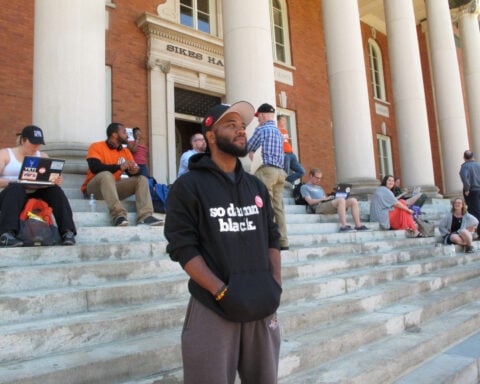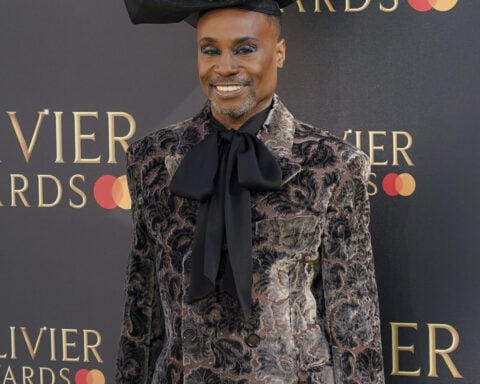(CNN) — He’s the mythical Celtic warlord who held out against the Anglo Saxon invasion of what would come to be called England. His right-hand man was a wizard, he was handed his famous sword by a deity, and he was a romantic — and chivalrous — hero.
Oh, and he isn’t dead. He’s merely asleep, and will rise again when the time is right to expel the invaders and turn Britain back into a Celtic land.
He is, of course, King Arthur, a figure so imbued with beauty and potential that even across the pond, JFK’s presidency was referred to as Camelot — Arthur’s mythical court. But was there a real man behind the myth? Or is he just our platonic ideal of a hero — a respectful king, in today’s parlance?

Today, Arthur’s supposed exploits have left behind a tourist trail across the UK and beyond, with scores of sites claiming connections to his myth.
It’s nothing new. For centuries, the legend of Arthur has fascinated much of Europe.
He was supposedly the leader of a tribe of Celts — indigenous Britons — when the Saxons invaded Britain in the fifth century.
The Saxons — people from modern-day Scandinavia, Germany and France — eventually colonized Britain, but there were fierce pockets of resistance from the Celts, especially in the far west of the country. Wales and Cornwall — England’s southwesternmost county – were the last to fall. The Celtic languages that all Britons originally spoke held out here, while elsewhere people began to speak what would become English.

Arthur was, according to tradition, a leader resisting to the end against the Saxon colonizers. Fittingly, both Cornwall and Wales (among other places) claim him. Today, he is best associated with Tintagel Castle, where remains of a settlement dating back to the fifth century perch strikingly on an islet off the wild coast of Cornwall. Supposedly, Arthur was conceived here.
But the myth of Arthur is also bound intrinsically with Glastonbury Tor (a hill in Somerset where Merlin, his magician, is said to be asleep, waiting to return), Caerleon Castle in Wales (this was said to where Arthur had his court, Camelot), and South Cadbury in Somerset, where archaeologists in the 1970s thought they’d located Camelot.
In Wales alone, Arthur is meant to have killed a giant on Yr Wyddfa (Mount Snowdon) and a fearsome beast in Llyn Barfog lake, while Merlin is said to be buried both on Bardsey Island, off the north coast, and in a cliff at Nevern. Mind you, Arthur is also rumored to be sleeping in that cliffside — as well as buried at Glastonbury Abbey, Baschurch in Shropshire, and Mynydd y Gaer, a mountain in Wales. Even for a mythical figure, he got around.
There’s also Arthur’s Seat in Edinburgh — the names of Arthur and Merlin are “right at the top of the list” of historical figures who’ve loaned their names to places, according to Mark Stoyle, professor of early modern history at the UK’s University of Southampton. Even the French claim a link with him, with some arguing that he was from Brittany — another Celtic part of Europe. The study of his story is, apparently, on the national school curriculum in France.

So why is everyone so fascinated with this man — and did he even exist?
An Arthur for all seasons
For Stoyle, it’s likely that the myth of Arthur has at least its roots in fact.
“Nobody knows for sure,” he says. “Historians are so divided on it.”

He says that an increasing number of archaeologists and historians believe that Arthur is an amalgamation of various historical characters, rather than an actual figure himself —although plenty still believe that Arthur himself existed.
Stoyle himself is in the former camp.
“When the Roman empire fell, the Anglo Saxons took over in the east of England and then moved to the west. There was fierce resistance to them which lasted a long time, and it’s easy to believe that there was one or more local chieftains who opposed them, and that those stories are perhaps the germ for the story of Arthur,” he says.
“My gut feeling is that there has to be someone extraordinary behind this [these stories] but we have so little hard evidence, and some things [which he is said to have done] he definitely couldn’t do.”
That would be things like pulling a sword out of a rock in which it was lodged (this marked him out as the rightful king), or getting his most famous sword, Excalibur, handed to him by “the lady of the lake,” a kind of water deity (Cornish people swear this happened at Dozmary Pool on Bodmin Moor). Excalibur has, of course, become so rooted in our global consciousness that it was not only the subject of the 1963 Disney film “The Sword in the Stone” but also is the name of a medieval-themed resort in Las Vegas.
Whoever inspired these stories is almost a moot point for Stoyle. “In a way, everybody has their own Arthur — perceptions about who we want him to have been,” he says.
Perhaps he’s the chivalrous knight who spent more time instilling good behavior at Camelot than killing his enemies. This is the Arthur that went viral in the medieval period, when chivalry was all the rage.
Perhaps he’s the romantic hero, the king who fought for love when his wife Guinevere ran off with his most trusted confidant, Lancelot. That’s the erotic Arthur beloved by the pre-Raphaelite artists and poets who obsessed over him in the 1800s. This Arthur was played by Clive Owen in the 2004 film, “King Arthur,” alongside Keira Knightley as Guinevere.
Perhaps he’s the mystic — the proto-New Age king who was led to victory by his trusted magician Merlin. Modern-day mystics swarm to Glastonbury to soak up his magic there.
Or maybe he’s supernatural — a man who never really died, but lies sleeping, ready to return when his country needs him. This Arthur will kick the Saxon colonizers out and return Britain to its native Celtic culture. That’s the guy who, says Stoyle, the Welsh and Cornish “absolutely believed” in for centuries.
As for Merlin, Stoyle says that most leaders of that age would have been accompanied by a sage. Merlin is the model in popular culture for the likes of Gandalf and Dumbledore, he says.
A medieval myth
In the medieval period, Arthur’s story — or, more accurately, his myth — went viral after a writer called Geoffrey of Monmouth described King Arthur in his book, “Historia Regum Britanniae,” or “A history of Britain’s kings,” around 1136 CE.
Geoffrey — thought to have been a monk — wrote that Arthur was conceived at Tintagel, and held court at Camelot — AKA Caerleon in southeast Wales, around 150 miles northeast of Tintagel.
According to Geoffrey, Arthur died fighting the forces of his wayward son Mordred at the battle of Camlann at Cornwall’s “River Camblan” — often interpreted as the River Camel, which coincidentally runs through a place called Slaughterbridge. He was buried on the island of Avalon — not located by Geoffrey, though the medieval monks of Glastonbury Abbey were quick to equate themselves with Avalon, not least because Arthur pilgrims were cash-rich visitors.
Of course, medieval history writers were fast and loose with the facts. But it seems that archaeology can provide some pointers.
Tintagel Castle is one of the most romantic sites connected with Arthur: an atmospheric ruined castle clinging to the cliffside of a small island, dangling just off the coast of the north Cornish coast.
So spectacular is its location that it’s the second most visited site for English Heritage, the charity that manages it, after Stonehenge. In 2023, 334,195 visitors made their way down from the cliffs at Tintagel village, into a valley, and up along another cliff to a suspension bridge.
The bridge — built in 2019 — leads visitors across an abyss, the Atlantic Ocean thrashing below, and onto the islet, where they walk straight into a ruined medieval dining hall on the side of the precipitous cliff.
Into the past
Arthur, so the legend goes, was conceived here – though of course not in that dining hall. In fact, the atmospheric medieval ruins we see today were built expressly to tap into the Arthurian myth, says Win Scutt, senior properties curator at English Heritage.
The castle was built by Earl Richard, the 13th-century duke of Cornwall — a role today held by Prince William.
“Earl Richard wanted to associate himself with the Arthurian story — that’s why he bought the land and built the castle,” says Scutt. “This was a feasting place to basically say he was the new Arthur.”
Further up on the clifftop, however, are remains that date back to the (supposed) Arthurian period.
Across the top of the headland spread the remains of a settlement from the fifth to the seventh century — the height of the “Dark Ages,” the post-Roman period in Europe when trading and transport routes broke down, and for which there is little written evidence.
Yet the archaeological evidence at Tintagel is compelling.
It shows that the site was home to an important settlement during the period, with evidence of long-distance trading: wine from Greece, serving bowls from Turkey, and Tunisian ceramics. There is more pottery from the eastern Mediterranean at Tintagel than from all other sites from the same era in Britain — put together.
“We don’t have a settlement in southern Britain as large as Tintagel — not even London,” says Scutt. There are traces of around 100 buildings scattered over the headland.
There’s also evidence of connections with early Christian culture in the eastern Mediterranean.
“Seven hundred years before the [medieval] castle there was a place of power there,” says Scutt, adding that there are few signs of military defenses, implying that it was a “high status site — more of a statement.”
“It’s not necessarily royal, but probably is,” he adds. “Cornwall was an independent kingdom in the early medieval period.”
Then there’s the “Artognou stone,” discovered onsite in 1998. A sixth-century carved stone, it mentions the name Artognou, which some people have connected to Arthur — though other scholars have dismissed this idea.
Scutt says that he and his colleagues have shied away in the past from linking Tintagel with Arthur too explicitly. Yet he is curious why Geoffrey of Monmouth chose it as Arthur’s place of conception.
“Where did he pick up this story? Oral history? Writing? Or did the people of Tintagel claim to have origins with Arthur? You can’t extricate the myth from the history,” he says. “Maybe he was aware there had been an important place.
“That [Geoffrey] connects the birth of Arthur with Tintagel can’t be a coincidence – there’s something going on there.” But, Scutt hastens to add, “That doesn’t mean [Arthur] existed. As an archaeologist, I never trust historical records. We always question the documentary record — especially if it’s from 500 years later.”
‘A complete spoof’
One person who isn’t convinced by Geoffrey’s account is Nicholas J. Higham, professor emeritus at the University of Manchester, who calls the text “a complete spoof… a faux history which lionizes the Britons and downgrades the English as pagan incomers who aren’t very nice.”
Higham likens Geoffrey’s text to the epic “Lord of the Rings” saga by J.R.R. Tolkien — who, incidentally, was an Arthurian scholar.
“You see him plucking stuff off [other source materials] and writing it into his own narrative,” he says. Those sources included a ninth-century document called “The History of the Britons” which “rewrote” the history of the Roman occupation of Britain to laud the indigenous Britons, and a 540 CE Latin document in the manner of an “Old Testament prophet” which suggests that the Britons were subdued because “they have gone against god, and they need to repent and return to the lord.”
This document — by a writer called Gildas — “builds up the figures of resistance [to the Romans],” says Higham, One of these figures in the text is Arthur. He is depicted as an almost Christ-like figure, the battle leader of the Britons, winning 12 battles — a number significant to Christians.
Old Welsh poetry of the eight to 11th century also mention Arthur, though Higham says that the texts we have today are medieval copies that were “radically modernized” and therefore untrustworthy.
There’s also a roundabout reference to Arthur in a sixth century poem, damning another figure as, “He was not an Arthur.”
“You can make of that what you will,” says Higham, who calls himself an “Arthur skeptic.” “You can’t accept the word of an early ninth-century writer who you know is attempting to rewrite the past for present propagandist purposes.”
Henry VIII, an unlikely superfan
Whatever the truth, the influence of Arthur has echoed down through the centuries.
In 1485, England’s King Henry VII seized power from Richard III by landing in Wales from his exile in Brittany (he had first tried to land in Cornwall), billing himself as “Arthur’s heir,” says Stoyle. “The prophecies that Arthur would come again encouraged the Welsh to join him, and his army snowballed.”
Once he’d grabbed the throne, he emphasized his Welshness, even calling his first son – the Prince of Wales — Arthur. Henry’s reign was, says Stoyle, a “glorious Welsh renaissance,” and Arthur — who was sent to the English town of Ludlow to govern as a young man — would have been crowned king of England had he not died early.
Instead, his younger brother took power — one Henry VIII. And although we think of Henry as the quintessential Englishman, Stoyle says he “emphasized his connection with Wales,” celebrating St. David’s Day in court and having a retinue of Welsh staff. He and his daughter, Elizabeth I, spoke both Welsh and Cornish. “The Tudors were really keen to say we are kings of England but also Wales and Cornwall,” says Stoyle. The later Stuart dynasty also played up links with Arthur, he says.
“It really shows Arthur mattered.”
Whatever the truth, those who love Arthur — the man, the myth, or the many men whose stories might have created the myth — have plenty of places to visit.
And the wonderful thing about the many Arthurs is that he can also tell us about ourselves.
“In a way, everybody has their own Arthur,” says Stoyle. “There are all kinds of Arthurs. At Glastonbury it’s very New Age-y. At Tintagel it’s more grim and forbidding, he’s more like a warrior. Most people think of him in a more romantic way. Different people gravitate to different places in search of ‘their’ Arthur.”
Scutt says that the legends are important as the truth — whatever that is.
“The legend is important — that’s our identity,” he says. “Some stories that we tell about our own families might not be very truthful but we remember them as part of us.
“As a child I used to write songs to do with the Arthur story and even called my bicycle Arthur.
“Do I want him to exist? I kind of do. But in a way, it doesn’t really matter. “
The-CNN-Wire
™ & © 2024 Cable News Network, Inc., a Warner Bros. Discovery Company. All rights reserved.

 Trump has begun another trade war. Here's a timeline of how we got here
Trump has begun another trade war. Here's a timeline of how we got here
 Canada's leader laments lost friendship with US in town that sheltered stranded Americans after 9/11
Canada's leader laments lost friendship with US in town that sheltered stranded Americans after 9/11
 Chinese EV giant BYD's fourth-quarter profit leaps 73%
Chinese EV giant BYD's fourth-quarter profit leaps 73%
 You're an American in another land? Prepare to talk about the why and how of Trump 2.0
You're an American in another land? Prepare to talk about the why and how of Trump 2.0
 Chalk talk: Star power, top teams and No. 5 seeds headline the women's March Madness Sweet 16
Chalk talk: Star power, top teams and No. 5 seeds headline the women's March Madness Sweet 16
 Purdue returns to Sweet 16 with 76-62 win over McNeese in March Madness
Purdue returns to Sweet 16 with 76-62 win over McNeese in March Madness








